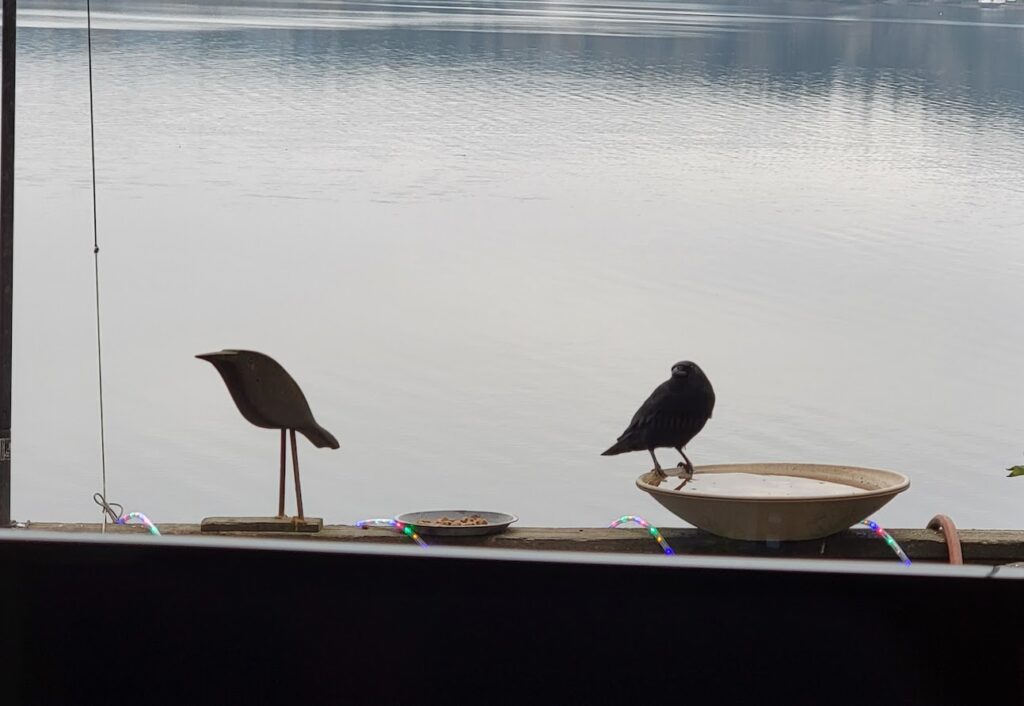By Seán Malone and John Sweetman
Seán has always fed birds, and his deck has been full of them ever since he began to live in the cabin. At first, I noticed at least one crow would be very skeptical if Seán poked his head out the patio door. Seán’s story explains why.
We were working on a complex wood project, and I noticed that some of the “cutout” pieces of clear cedar sort of looked like birds, and one piece just appeared to have a crow hidden in the rough shape. I fooled around, carving and polishing this for some time, and after several tries, mounted it on a small platform with crow-like legs and carved crow eyes.
Right away, after mounting this piece on the rail, the crows noticed and were eager to check it out, although still a bit skeptical of Seán. They would alight on the rail without the previous “slink” eye glance toward Seán, although there was still a certain wariness.
I think, after 75 years or so, Seán, if not actually forgiven for his youthful transgressions, has at least been granted a temporary dispensation. Crows have long memories. They now alight on the rail and seem to hold more of a grudge towards the squirrels than Seán.
Seán related this following story to me as we polished the wooden crow and fixed the legs after a severe storm.
In the old days, there was a 25-cent bounty on crows because of the damage they did to the farmer’s crops. I never collected, but hunted the crows for sport. Dad told us to stay hidden and try to wing a crow, because their cawing from the ground would bring the whole flock, providing a chance for a lot more shots until they figured out where you were.
If you were lucky enough to kill a crow, the flock would gather in a nearby tree to silently recognize their dead friends.
Crows are so smart that, if you pointed a stick at them and went “bang-bang,” you would be ignored. They recognized the threat if they could see your gun.
When I was 14 years old, I went to McCormick’s Hardware and picked out a single-shot Stevens 20 gauge shotgun for $24.50. I also bought a $2.50 crow call, and when Earl McCormick handed it to me, he had tied a white string around it, so it hung around my neck and away from any dirt that would interrupt the fluttering reed that imitated the call of a crow. Two years later, I added a foot to the string so I could get it over my head and make another successful crow hunt.
I was at the mouth of Raab’s Lagoon and well-hidden in the brush while I called the crows. One flew over; we called him the lookout, as he perched above my head and started to call the other crows. As Dad had taught me, I shot at the lookout, causing him to fall to the ground, where he continued to call in frantic bursts that drove the flock to a flurry of dives at my position, giving me multiple shots.
The flock then retired to a single tree out of range of my shotgun, and remained there for 10 or 15 minutes while they mourned their fallen comrades.
Crows have remarkable memories that are passed over generations, to warn other crows of a dangerous person.
My great-grandfather, Nels Mattson, was a Danish doctor who settled at Portage in 1892. There were flocks of crows in the 1950s that numbered in the thousands; now you might see 20 or 30. We never shot at them near the homestead at Portage, and even now they fly to the deck rail for bread scraps with no fear. While I live on the outer harbor and can’t stand up to feed them, that doesn’t cause the crows to fly away. They remember my face.

